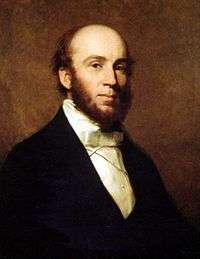
Charles Piazzi Smyth
Charles Piazzi Smyth FRSE FRS FRAS FRSSA (3 January 1819 – 21 February 1900), was Astronomer Royal for Scotland from 1846 to 1888, well known for many innovations in astronomy and his pyramidological and metrological studies of the Great Pyramid of Giza.
Astronomical career
Charles Piazzi Smyth (pronounced /ˈsmaɪθ/) was born in Naples, Italy, to Captain (later Admiral) William Henry Smyth and his wife Annarella. He was called Piazzi after his godfather, the Italian astronomer Giuseppe Piazzi, whose acquaintance his father had made at Palermo when serving in the Mediterranean. His father subsequently settled at Bedford and equipped there an observatory, at which Piazzi Smyth received his first lessons in astronomy. He was educated at Bedford School until the age of sixteen when he became an assistant to Sir Thomas Maclear at the Cape of Good Hope, where he observed Halley's comet and the Great Comet of 1843, and took an active part in the verification and extension of Nicolas Louis de Lacaille's arc of the meridian.

Piazzi Smyth (crater)
Piazzi Smyth is a small lunar impact crater in the eastern part of the Mare Imbrium. This is an isolated feature located about 100 kilometers to the southwest of the Montes Alpes mountain range. To the southeast of this crater is Mons Piton, an isolated mountain that rises to a height of 2.3 km and occupies a diameter of about 25 km.
This crater is a nicely circular feature with a rim and interior that have not been significantly modified by impacts. The inner walls slope smoothly downwards to the small floor about the midpoint, which occupies a diameter of only one-fifth the total diameter of the crater. This formation has no other notable features, and its albedo matches the surrounding lava plain.
Satellite craters
By convention these features are identified on lunar maps by placing the letter on the side of the crater midpoint that is closest to Piazzi Smyth.
References
Podcasts:

